1. Introduction
The study of exhumed accretionary complexes, especially of their deep parts which experienced high pressure/low temperature (HP/LT) metamorphism and which are exposed in collision belts, provides key information about the tectonic processes active along subduction zones. An example of a tectonic process that is suspected to occur at depth in subduction zones is tectonic underplating, that is, the incorporation into the upper plate of rocks units (sedimentary rocks and oceanic crust rocks) originally belonging to the lower (subducting) plate. Tectonic underplating is assumed to be currently active in various convergent margins where various pieces of evidence are documented. Across the North America plate margin in Alaska, seismic reflection profiles show flat reflectors at 10–25 km depths interpreted as reverse faults delimiting thrust sheets of material accreted to the upper plate (J. C. Moore et al., 1991; Fuis et al., 2008). In central Japan, micro-earthquake distribution at the top of the Philippine Sea plate subducting beneath Eurasia in the Kanto region is similarly interpreted as the consequence of active underplating at 15–20 km depths (H. Kimura, Takeda, et al., 2010). In the same area and in the same depth range, repeatedly occurring micro-earthquakes are associated with slow-slip events, both possibly being related to underplating (H. Kimura, Kasahara, Igarashi, et al., 2006; H. Kimura, Kasahara and Takeda, 2009). Marine seismic reflection profiling across the Hikurangi margin northeast of New Zealand revealed a low-seismic velocity zone interpreted as caused by trench-filling sediments and crustal rocks being currently underplated at 5–35 km depths (Bassett et al., 2010). Underplating is also inferred from sedimentological or structural evidence in several exhumed ancient active margins such as Makran (Burg, 2018; Platt, Leggett, et al., 1985), Kodiak (Byrne, 1986; Sample and D. M. Fisher, 1986), Shimanto (G. Kimura and Mukai, 1991; Matsumura et al., 2003; Raimbourg et al., 2014), or Franciscan complex and Klamath mountains (G. Kimura, Maruyama, et al., 1996; Meneghini et al., 2009; Tewksbury-Christle et al., 2021; Platt and Schmidt, 2024). The long-term record of underplating is suggested by episodes of coastal area uplift lasting for several million years (Menant et al., 2020; Rossetti, Fellin, et al., 2024). Lastly, the preservation of imbricated thrust sheets made of high-pressure/low-temperature (LP/LT) blueschist to eclogite facies rocks suggests that underplating took place at depths in several subduction or collision settings (Agard et al., 2018; Angiboust and Agard, 2010; Angiboust, Glodny, et al., 2014; Angiboust, Menant, et al., 2021; Austrheim and Boundy, 1994; C. J. Warren et al., 2008).
The aim of this contribution is to interpret previously described structural data pertaining to pseudotachylyte-bearing faults and associated cataclastic structures in ultramafic rocks exposed in ophiolitic units from Alpine Corsica (Andersen and Austrheim, 2006; Magott et al., 2016; Magott et al., 2017; Fabbri et al., 2018), and to discuss a possible mechanism of incorporation, by tectonic underplating, of the ultramafic rocks from the subducting lithospheric mantle to the upper plate. Newly obtained 40Ar/39Ar ages of gabbro-hosted pseudotachylyte veins further provide a time constraint on the proposed model.
2. Geological setting
2.1. Alpine Corsica
Alpine Corsica mostly consists of metamorphosed ophiolitic units interpreted as remnants of the lithosphere of the Piemonte-Ligurian ocean formed by the sea-floor spreading in the Jurassic between the European and the Adria plates or an intervening microplate (Manatschal and Bernoulli, 1998; Piccardo and Guarnieri, 2010; Rampone et al., 2008). Most palaeogeographic reconstructions propose that, from the Late Cretaceous to Palaeogene, the Piemonte-Ligurian lithosphere subducted eastward or southeastward beneath Adria or beneath an Adria-derived microplate, and was succeeded by a collision between Europe and Adria in the Eocene to the Oligocene (Mattauer et al., 1981; Malavieille et al., 1998; Stampfli et al., 2002; Handy et al., 2010; Molli and Malavieille, 2010; Turco et al., 2012; Vitale-Brovarone, Beyssac, et al., 2013; Marroni et al., 2017). The HP/LP metamorphism recorded in ophiolitic units, which includes lawsonite-eclogite facies metamorphic rocks (Ravna et al., 2010; Vitale-Brovarone, Groppo, et al., 2011), is ascribed to the subduction of the oceanic lithosphere down to 60–80 km depths. The initial decompression from lawsonite-eclogite metamorphism took place at blueschist facies conditions (Ravna et al., 2010) and was succeeded by regional greenschist facies metamorphism during the later stages of exhumation (Fournier et al., 1991; Jolivet et al., 1990). Radiometric ages of the HP/LT metamorphism by various methods (39Ar/40Ar on micas and amphiboles, U–Pb on zircon, U–Pb thermal ionisation mass spectrometry on rutile, Lu–Hf on garnet and lawsonite) are between 55 and 34 Ma (Amaudric du Chaffaut and Saliot, 1979; Beaudoin et al., 2020; Brunet et al., 2000; Maggi et al., 2012; Martin et al., 2011; Vitale-Brovarone and Herwartz, 2013). Rb-Sr and 39Ar/40Ar ages of the retrograde greenschist facies metamorphism partly overlap those of the HP/LT metamorphism, and are comprised between 32 Ma to c. 15 Ma (Beaudoin et al., 2020; Brunet et al., 2000; Rossetti, Glodny, et al., 2015).
2.2. The studied units and associated pseudotachylyte veins
This study focuses on two ophiolitic units exposed in the northern part of Corsica, in Cape Corse, namely the Monte Maggiore and the Cima di Gratera units (Figure 1). These units consist of variably serpentinized lherzolite-type peridotite with subordinate metagabbro (Figure 2). The Monte Maggiore unit mostly consists of a weakly to moderately serpentinized peridotite, inside which gabbro is only exposed as cm-thick dykes cross-cutting the peridotite (Jackson and Ohnenstetter, 1981). Pseudotachylyte veins in the Monte Maggiore unit are rare and are hosted in a peridotite which locally shows evidence for cataclasis (see below and Fabbri et al., 2018). The Cima di Gratera unit shows, from base to top (Figure 2d), (1) a serpentinite substratum including lenses of oceanic gabbro and thrust sheets of continental crust-derived gneiss (D. Lahondère, 1988), (2) a lower ultramafic sub-unit consisting of serpentinite and peridotite, the latter being more abundant upward, and (3) an upper gabbro sub-unit. The contact between (1) and (2) is a flat or gently undulating contact (φ1). Immediately above φ1, and over a thickness of c. 100 m, the serpentinite is strongly foliated. The variety of shear directions and shear senses indicated by sigmoidal lenses and shear bands precludes a determination of φ1 kinematics. The contact between (2) and (3) is also a flat or gently undulating fault (φ2). It is characterised by heterogeneously distributed brittle and ductile deformation structures (Andersen, Austrheim, et al., 2014; Magott et al., 2016; Magott et al., 2017). In some places, the φ2 contact consists of a thick (∼0.8 m) accumulation of pseudotachylyte (Andersen, Austrheim, et al., 2014). In other places, the footwall peridotite contains only a few pseudotachylyte veins, and the hanging-wall gabbro is mylonitic over a thickness of c. 20 m (Magott et al., 2016). The foliation is parallel to φ2 and progressively disappears upwards. In the Cima di Gratera unit, pseudotachylyte veins are hosted in fresh or weakly serpentinized (<10% serpentinisation) peridotite and also in the overlying metagabbro sub-unit (Andersen and Austrheim, 2006; Andersen, Mair, et al., 2008; Andersen, Austrheim, et al., 2014; Austrheim and Andersen, 2004; Deseta, Andersen, et al., 2014; Deseta, Ashwal, et al., 2014; Magott et al., 2016; Magott et al., 2017). The veins are widespread across the entire unit, but their abundance is highest along or near φ2 (Figure 2). In the gabbro sub-unit, immediately above φ2, where pseudotachylyte fault veins are parallel to the foliation, they are ductilely deformed. Where they cross-cut the foliation, the veins are free from any ductile deformation. These relationships show that ductile and brittle deformation conditions overlapped (Magott et al., 2016). Where the footwall consists of peridotite, abundant pseudotachylyte fault veins parallel to φ2 are present over a thickness of about 100 m. The vein thickness, lateral extent and abundance decrease downwards with the increasing distance to φ2. Where the footwall consists of a serpentinite, pseudotachylyte veins are rare or absent and the serpentinite acquires a foliation parallel to φ2 (Magott et al., 2017).

(A) Geographical setting of Corsica. (B) Geological setting of the studied ophiolitic units in Cape Corse. Insets (A) and (C) refer to maps (A) and (C) of Figure 2.
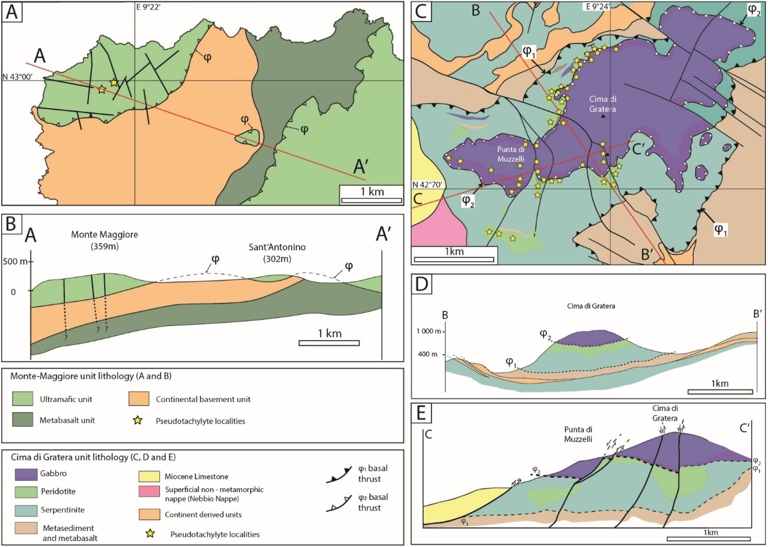
(A) Geological map of the Monte Maggiore unit. (B) Cross-section of the Monte Maggiore unit. (C) Geological map of the Cima di Gratera unit. (D) and (E) Cross-sections of the Cima di Gratera unit. Note that, for clarity, late steeply dipping normal faults are not depicted on section B–B′.
In the two studied areas, late vertical to steeply dipping faults cross-cut the ophiolitic units (J. C. Lahondère et al., 1992; Magott et al., 2016). In the Monte Maggiore unit, due to poor exposure, the sense of displacement along these late faults remains undetermined. In the Cima di Gratera area, these faults offset the contact φ2 with a normal sense. This displacement is likely related to the Oligocene to Miocene extension that led to the formation of the Liguro-Provencal basin and the Tyrrhenian sea on each side of Corsica (Daniel et al., 1996; Brunet et al., 2000).
2.3. Estimates of metamorphic conditions in the studied ophiolitic units
In the Monte Maggiore unit, the peridotite-hosted gabbro contains mineral assemblages and textures (partial replacement of plagioclase by jadeite + zoisite + paragonite + chlorite, glaucophane overgrowths around primary clinopyroxene) typical of blueschist facies metamorphic conditions (450 °C, 0.85 GPa) (Jackson and Ohnenstetter, 1981; Magott et al., 2020; Nicollet et al., 2001) which show that the gabbro and the host peridotite were subducted to minimum depths of 30–35 km. The peak metamorphic conditions recorded by mafic rocks in and around the Cima di Gratera unit plot in the field of lawsonite-bearing blueschist facies conditions, with temperature estimates at 400–430 °C and pressure estimates at 1–1.8 GPa (Vitale-Brovarone, Groppo, et al., 2011; Vitale-Brovarone, Beyssac, et al., 2013; Vitale-Brovarone, Picatto, et al., 2014; Vitale-Brovarone, Piccoli, et al., 2021). The pressure estimates suggest that the Cima di Gratera unit was subducted to depths between 30 and 60 km.
2.4. Metamorphic conditions recorded by the pseudotachylyte veins
In the Cima di Gratera ultramafic sub-unit, the chemical composition of clino- and ortho-pyroxene microlites in the pseudotachylyte veins suggests crystallisation under 1 to 1.5 GPa ambient pressures (Andersen and Austrheim, 2006; Andersen, Mair, et al., 2008). These pressure estimates were lowered to 0.5 GPa (∼17 km) (Ferré et al., 2017; Hosseinzadehsabeti et al., 2021), based on the presence of dendritic magnetite microlites and vesicles in the ultramafic pseudotachylyte. In the mafic sub-unit veins, the presence of omphacite microlites (Deseta, Andersen, et al., 2014; Magott et al., 2016), indicates pressure conditions of at least 1 GPa, in agreement with estimates by Austrheim and Andersen (2004). Despite the limitations mentioned above, most inferred pressures are around or above 1 GPa in the two sub-units, suggesting burial depths of at least 30–35 km. It is worth being noted that, based on the presence of neocrystallised spinel in an occurrence of peridotite-hosted pseudotachylyte located in the central part of Alpine Corsica, Vitale-Brovarone, Piccoli, et al. (2021) provide a minimum pressure estimate of 0.8 GPa, which is consistent with the pressure estimates in the areas studied here.
3. Structural and geochronological results
3.1. Pseudotachylyte veins, cataclastic layers, and cataclastic foliation and their spatial association
In the ultramafic sub-units, pseudotachylyte fault veins are often flanked by cataclastic peridotite. In the Cima di Gratera sub-unit, the degree of cataclasis progressively increases with proximity to the veins, with a transition from proto-cataclastic peridotite at a distance from the veins to ultra-cataclastic peridotite close to the veins (Magott et al., 2016). The timing of cataclasis overlaps that of frictional melting, as attested by the reworking of pseudodachylyte fragments in cataclastic rocks or by pseudotachylyte veins cross-cutting cataclasite. In the Monte Maggiore unit, pseudotachylyte fault veins are associated with cataclasite layers whose thickness is between a few millimetres and 2 cm (Figure 3, Fabbri et al., 2018). The cataclastic layers have sharp planar boundaries with the host rock and consist of minute fragments of peridotite-forming minerals or mineral assemblages (ibid.). In most cases, pseudotachylyte veins and cataclasite layers are parallel. Cataclasis also affects the pseudotachylyte-hosting peridotite or serpentinized peridotite in a more diffuse manner (Figure 3), under the form of several metres thick foliated zones which, due to the scarcity of exposure, could not be mapped in detail. Inside these zones, the peridotite is foliated and serpentinized. Thin section observation shows that the foliation is cataclastic. Infra-millimetric layers of mineral fragments separate millimetres-thick layers inside which minerals are still recognisable, although variously serpentinized (ibid.). Serpentinisation increases from the infra-millimetric layers outwards. In most occurrences, the foliated zones are flat-lying (Figures 4B and 5A). In some exposures, the cataclastic foliation dips moderately to steeply (Figures 4B and 5B).
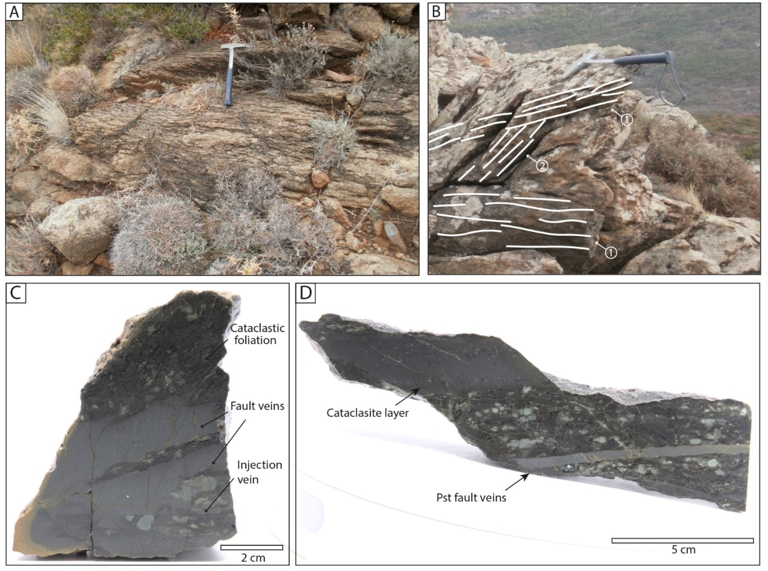
Cataclastic foliation and pseudotachylyte and cataclasite veins in the Monte Maggiore ultramafics. (A) Flat-lying cataclastic foliation. (B) Gently dipping cataclastic foliation (2) deflected by a flat-lying cataclastic foliation (1). (C) Serpentinized peridotite hand-sample- hosting flat-lying pseudotachylyte veins. (D) Foliated serpentinite hand-sample showing a flat-lying pseudotachylyte vein and a cataclastic layer.
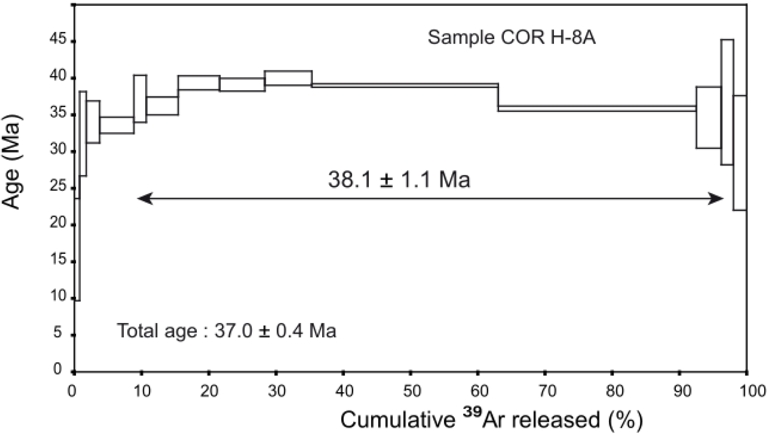
40Ar/39Ar age spectrum of the gabbro-hosted pseudotachylyte injection vein COR H-8A. The double arrow indicates the range of released cumulative 39Ar (%) regarded as a plateau from which the 38.1 Ma age of formation is derived.
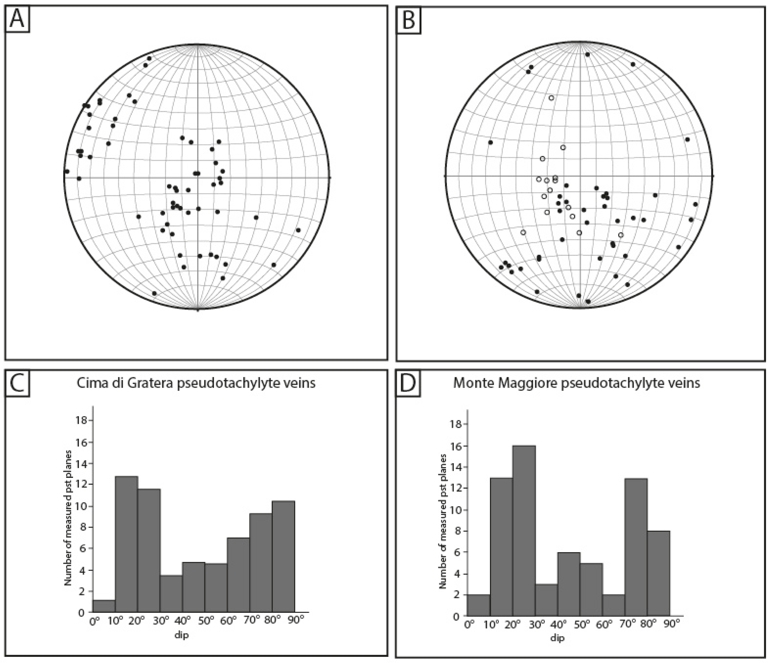
Attitude of pseudotachylyte veins, cataclastic layers and cataclastic foliation in ultramafic rocks. (A) Lower hemisphere equal-area projection of poles to pseudotachylyte fault veins in the Cima di Gratera ultramafic sub-unit (56 measurements). (B) Lower hemisphere equal-area projection of poles to pseudotachylyte fault veins (solid circles), cataclastic layers (triangles) and cataclastic foliation (open circles) surfaces in the Monte Maggiore ultramafic rocks (61 measurements). (C) Histogram showing the distribution of dip angles for pseudotachylyte fault veins at Cima di Gratera. (D) Same for Monte Maggiore. Masquer
Attitude of pseudotachylyte veins, cataclastic layers and cataclastic foliation in ultramafic rocks. (A) Lower hemisphere equal-area projection of poles to pseudotachylyte fault veins in the Cima di Gratera ultramafic sub-unit (56 measurements). (B) Lower hemisphere equal-area projection of poles to ... Lire la suite
3.2. Age of formation of the pseudotachylyte veins
In order to determine whether the pseudotachylyte veins were formed during oceanic accretion along normal faults at the mid-oceanic ridge, before subduction by outer-rise normal faulting near the trench, or during subduction along the plate interface, 40Ar/39Ar laser probe dating of pseudotachylyte samples was carried out (Monié et al., 2024). Due to their low K content, peridotite-hosted veins did not provide meaningful results. Conversely, three gabbro-hosted veins with sufficient K content were dated. Each age spectrum was obtained on a single millimitre-sized, thin and translucent fragment of pseudotachylyte glassy matrix optically free of any survivor clasts. The samples were step-wise heated for 30 s with a CO2 laser using a beam diameter of about 300 μm. Slightly moving the sample under the laser beam ensures homogeneous heating. After purification, the gases were introduced into an Argus VI mass spectrometer and analysed by peak switching. Ages were calculated using the ArArCALC software. More details can be found in Monié et al. (2024) and references therein. The obtained ages date the cooling of the melt, a few tens of seconds or a few minutes after seismic slip-related frictional melting. One sample (COR H-8A) provides a reliable age at 38.1 ± 1.1 Ma and a total gas age of 37.0 ± 0.4 Ma (Figure 4 and Supplementary Material). A second sample (COR G-17A) yields 42 ± 8 Ma. The large error margin regarding this age is due to excess argon. The third dated sample gives a poorly constrained age at 55 ± 11 Ma.The large error margin is here also due to excess argon. The reliability and significance of these three ages are discussed below (Section 4.1), but the obtained values confirm that the studied pseudotachylyte veins were formed under HP/LT metamorphic conditions during subduction.
3.3. Bimodal distribution of dip angles of pseudotachylyte veins, cataclastic layers and cataclastic foliation, and relative chronology
As reported by Andersen and Austrheim (2006) and by Magott et al. (2016), in the Cima di Gratera ultramafic sub-unit, the attitude of pseudotachylyte fault veins is clustered around N0 ± 45°, but their dip angles show a bimodal distribution. They either dip gently (0–10°) or steeply (45–70°) eastward (Figures 5 and 6). A similar bimodal distribution is observed for pseudotachylyte fault veins, cataclastic layers and cataclastic foliation in the Monte Maggiore area (Figure 5).
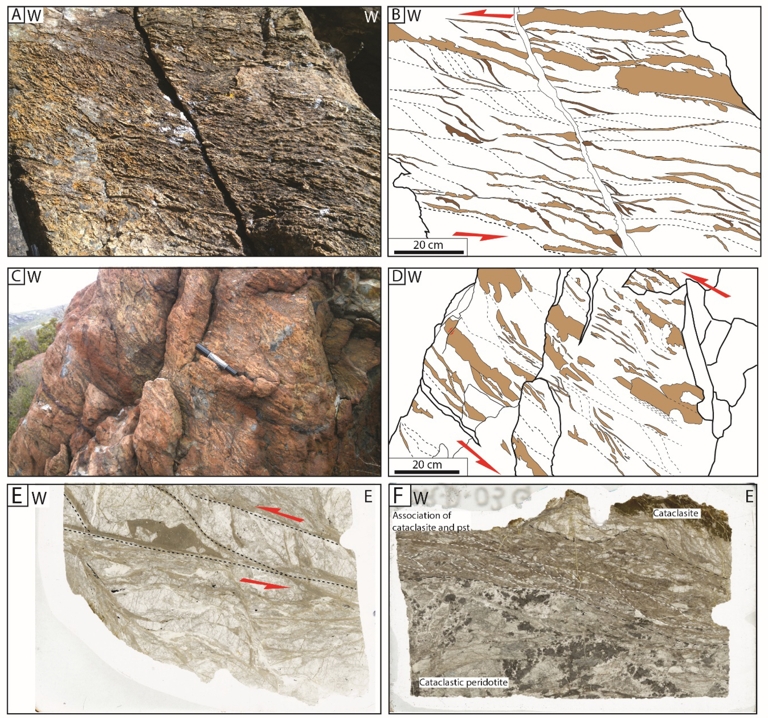
Pseudotachylyte and cataclasite in the Cima di Gratera ultramafic sub-unit. (A)–(B) Flat-lying pseudotachylyte veins (light brown) cross-cutting steeply dipping veins (dark brown) near φ2 contact. (C)–(D) Steeply dipping pseudotachylyte veins associated to cataclasite bands (dark brown in (C)). (E) Thin section showing association of cataclastic bands with flat-lying pseudotachylyte. (F) Polyphase pseudotachylyte/cataclasite flat-lying shear band displaying S–C microstructure.
Whatever the unit, no relative chronology between flat-lying and steeply dipping veins can be ascertained. In some instances, flat-lying veins cross-cut steeply dipping ones, but the reverse relationship is also observed. This lack of unambiguous chronology suggests a contemporaneity between the two types of fault veins. Similarly, no relative chronology can be established for the cataclasite layers in the Monte Maggiore unit. Regarding the diffuse cataclastic foliation observed at Monte Maggiore, the flat-lying foliation offsets the steeply dipping one, with a marked deflection, suggesting that the former is younger than the latter (Figure 3B).
3.4. Sense of displacement along the pseudotachylyte veins and cataclastic layers
The sense of displacement along pseudotachylyte veins and cataclastic layers is determined at the hand-sample or thin-section scale using various indicators such as offset markers or secondary fracture networks (Fabbri et al., 2018; Magott et al., 2016). Given the N0 ± 45° strike of pseudotachylyte veins and cataclastic layers, the sense of displacement is top-to-the-west, southwest or northwest. Such a kinematics is in agreement with an eastward subducting Piemonte-Ligurian oceanic lithosphere and top-to-the west (antithetic) reverse faulting in the subduction zone (Faure and Malavieille, 1981; Mattauer et al., 1981; Molli and Malavieille, 2010). The top-to-the-west sense of shear is questioned by Hosseinzadehsabeti et al. (2021). According to this study, magnetic fabrics frozen in the Cima di Gratera pseudotachylyte veins would indicate top-to-the-east shear senses during the formation of the melt. Among the various kinematics of intraslab earthquakes at 35–70 km depths, normal (i.e., synthetic) reactivations are reported from several subduction zones (see Section 4.3 below). The top-to-the-east shear sense obtained by Hosseinzadehsabeti et al. (ibid.) could be relevant to these normal (synthetic) reactivations.
4. Interpretation and discussion
4.1. Significance of the Eocene ages of pseudotachylyte veins
As mentioned above, 40Ar/39Ar laser probe dating of the glassy matrix of pseudotachylyte veins hosted in a gabbro in the Cima di Gratera area yields a reliable age at 38.1 ± 1.1 Ma (Figure 3), that is, Bartonian (middle-late Eocene) and two less constrained ages at 42 ± 8 Ma (Lutetian) and 55 ± 11 Ma (Ypresian). For these last two samples, the large error margins are due to excess argon contamination. Despite the uncertainties, the three ages fall in the range of 50–33 Ma ages so far obtained for the Alpine HP/LT metamorphic peaks in the internal Alps (Bonnet et al., 2022). Restricting the results to the Piemonte-Liguria units (Zermatt-Saas, Rocciavrè, Monviso, Voltri), the obtained pseudotachylyte vein ages also fall in the 50–38 Ma range of HP/LT metamorphic peak ages. Lastly, the pseudotachylyte ages compare well with the 37.5–34.1 Ma range of HP/LT metamorphism obtained in Corsica by zircon U/Pb, garnet Lu/Hf or lawsonite Lu/Hf methods (Martin et al., 2011; Vitale-Brovarone and Herwartz, 2013). This confirms that the studied pseudotachylyte veins were formed during subduction, and not during normal faulting at the mid-oceanic ridge or at the trench outer rise where the subducting plate is being bent.
4.2. Tentative interpretation of basal contacts and pseudotachylyte veins, cataclastic layers and cataclastic foliation
Figure 8 depicts a possible scenario in which a basal decoupling surface propagates through the subducting lithosphere, allowing formation and imbrication of ultramafic thrust sheets. A present-day analogue for this scenario can be found in seismic reflection profiles across the Sumatra trench where the Indo-Australian oceanic lithosphere subducts beneath the Sunda block (Singh et al., 2012), or across the Nankai Trough where the Philippine Sea plate subducts beneath Eurasia (Tsuji, Park, et al., 2009; Tsuji, Kodaira, et al., 2013). In the Corsican case, the basal surface could be φ at Monte Maggiore or φ1 at Cima di Gratera. First-order steeply dipping ramps delimiting the thrust sheets have not been identified in the studied areas. However, the vertical to steeply dipping faults mapped in the studied areas (J. C. Lahondère et al., 1992; Magott et al., 2016; Magott et al., 2017), which likely accommodated late, post-metamorphic crustal extension in Oligocene to Miocene times (Daniel et al., 1996), could be possible candidates. However, due to poor exposure conditions, the early, pre-to syn-metamorphic history, if any, of these faults is unknown, and the existence of first-order ramps remains hypothetical. Above the basal contacts φ or φ1 (Figures 7 and 8), steeply dipping pseudotachylyte veins, cataclastic layers and cataclastic foliation could correspond to second-order displacement surfaces parallel to first-order ramps while flat-lying or gently dipping pseudotachylyte veins, cataclastic layers and cataclastic foliation could correspond to second-order displacement surfaces parallel to first-order contacts below (φ or φ1) or above (φ2).
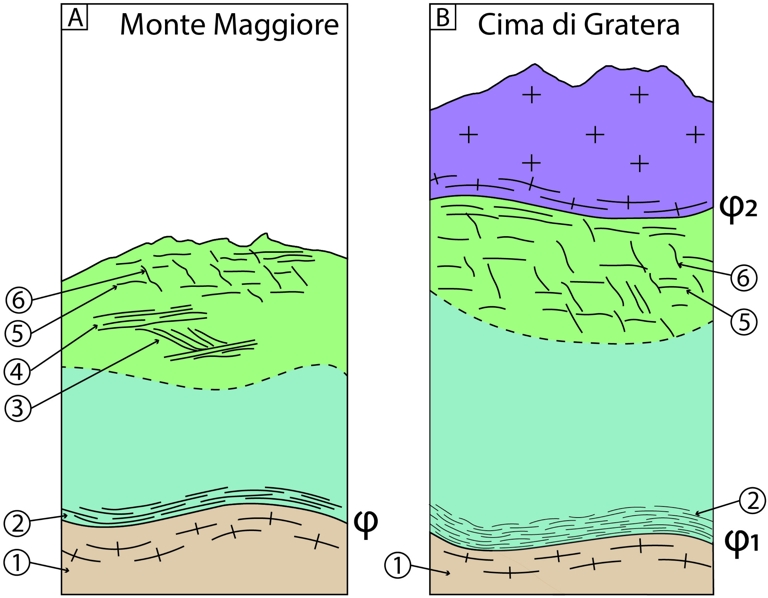
Summary of the geometry of pseudotachylyte veins, cataclastic layers and cataclastic foliation in the Monte Maggiore and Cima di Gratera units. Keys to numbers: (1) Foliated paragneiss or orthogneiss of the continental crust-derived basal units. (2) Foliated serpentinite along the basal thrust surfaces. (3) Steeply dipping cataclastic foliation. (4) Flat-lying cataclastic foliation. (5) Flat-lying pseudotachylyte fault veins and cataclastic zones. (6) Steeply dipping pseudotachylyte fault veins and cataclastic zones.
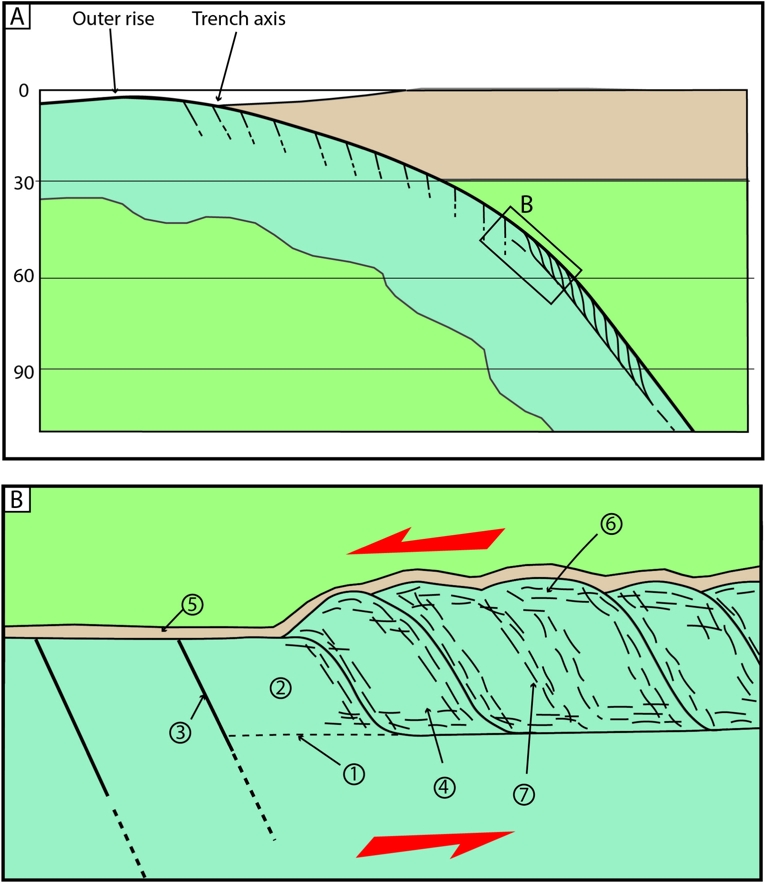
Interpretative model for underplating of the uppermost part of the subducting Piemonte-Ligurian oceanic lithosphere. (A) General framework showing outer rise bending-related normal faulting near the trench, and propagation and underplating at depth. (B) Enlarged view of the forward propagation of the thrust sheets through imbrication. Keys to numbers: (1) Propagating basal thrust surface. (2) Soon-to-be incorporated thrust sheet. (3) Outer-rise normal fault prone to reactivation as a thrust sheet-bounding fault. (4) Underplated thrust sheet. (5) Metamorphosed basalts and sedimentary cover. (6) Flat-lying structures (pseudotachylyte fault veins, cataclastic veins, cataclastic foliation). (7) Steeply dipping structures (pseudotachylyte fault veins, cataclastic layers, cataclastic foliation). Masquer
Interpretative model for underplating of the uppermost part of the subducting Piemonte-Ligurian oceanic lithosphere. (A) General framework showing outer rise bending-related normal faulting near the trench, and propagation and underplating at depth. (B) Enlarged view of the forward propagation of ... Lire la suite
The hypothetical steeply dipping first-order ramps delimiting the thrust sheets could be reactivated normal faults formed at the trench outer rise, where the lithosphere is bent before being subducted (Kobayashi et al., 1998; Masson, 1991). If this hypothesis is valid, then the thrust sheet thickness should be of the same order of magnitude as the spacing of outer-rise faults, that is, 2–10 km (Kobayashi et al., 1998; Ranero et al., 2005).
4.3. Comparison with intermediate-depth intraslab earthquakes
The tentative interpretation proposed above may be similar to mechanisms of tectonic incorporation and transfer of material from the subducting to the overriding plate documented in active subduction zones. A significant part of the earthquakes occurring in subducting slabs at 30–90 km or larger depths is interpreted as the reactivation of so-called outer-rise normal faults formed during the bending of the subducting oceanic plate near the trench (Barnhart et al., 2014; Hasegawa et al., 2007; Jiao et al., 2000; Lay et al., 2013; Malatesta et al., 2024; Marot et al., 2012; Ohta et al., 2011; Okada and Hasegawa, 2003; Ranero et al., 2005; L. M. Warren, 2014; L. M. Warren, Hughes, et al., 2007; L. M. Warren, Langstaff, et al., 2008). Such outer-rise faults dip about 60° (either landward or seaward) and can therefore correspond to steeply dipping fault surfaces assumed here. Among these faults, the candidates that would satisfy the comparison with the Corsican case should dip landward and should be reactivated with a reverse sense of slip. Flat-lying analogues should be parallel to the slab upper surface and should also be reactivated with a reverse sense of slip. A possible modern analogue is a sequence of earthquakes (two main shocks and many aftershocks) that occurred in 2002–2003 in the subducting Pacific plate beneath NE Japan (Hasegawa et al., 2007; Okada and Hasegawa, 2003). Two seismic fault surfaces were identified at a 30–70 km depth range. A reverse fault parallel to the slab upper surface, and a landward-dipping reverse fault making an angle of about 60° with the slab upper surface. This pair of faults appears as an analogue to the flat/ramp system mentioned above. Another analogue, although geometrically less constrained than the NE Japan case, is provided by micro-seismic activity at a 15–20 km depth range in central Japan. Repeating micro-earthquakes and slow-slip events occur near the boundary between the subducting Philippine Sea oceanic plate and the overriding Eurasian plate (Kato et al., 2010; H. Kimura, Takeda, et al., 2010). Seismic reflection profiles suggest slicing (off peeling) of the top of the subducting plate and incorporation of material into the upper plate (H. Kimura, Takeda, et al., 2010).
4.4. Magnitude of the seismic ruptures and possible relationship between cataclasis and slow slip
Among the pseudotachylyte veins, cataclastic layers and cataclastic foliation studied here, pseudotachylyte fault veins result from co-seismic displacement. An estimation of the magnitude of the earthquakes leading to the formation of these veins could extend or strengthen the comparison with present-day intra-slab seismicity. This estimation is however approximate because of several unknowns. (1) A given vein may correspond to a unique earthquake or to several ones. (2) Conversely, a given earthquake can produce one or several veins, and in the case of several veins, the exact number cannot be readily determined. (3) The volume of formed pseudotachylyte is difficult to estimate, because of the two-dimensional exposure limitation or the uncertainty regarding the volume of melt injected in non-exposed or eroded injection veins.
The pseudotachylyte veins described above and which are interpreted to correspond to the tectonic slicing of packages of subducting slab mantle rocks have lateral extensions of less than a few metres (<8 m) and thicknesses of a few millimetres (2.5–5 mm on average). For any such fault vein, the amount of melt exposed to a single vein remains small, in the order of a few tens of cm3 to no more than 1 m3. If a fault vein results from frictional melting during one earthquake, the small volume of melt suggests that the magnitude of the corresponding event was small. Using the same reasoning to estimate the magnitude of an earthquake from the amount of melt produced by this earthquake as in Magott et al. (2020), the above-mentioned volumes (50 cm3–1 m3) could have been produced during events with magnitudes between −1 and +1.8 (Supplementary Material 4). Such magnitudes fall in the range of magnitudes of micro-earthquakes, that is, earthquakes with magnitudes not exceeding ∼3. This analysis does not apply to several metres long and and several tens of centimetres thick pseudotachylyte veins described along φ2 by Andersen and Austrheim (2006) and Andersen, Austrheim, et al. (2014). Indeed, as shown by Andersen and Austrheim (2006) and Andersen, Austrheim, et al. (2014), these major veins were formed during large-magnitude (M ∼ 7 or 8) events with large rupture areas (megathrust earthquakes).
The cataclastic fabric and the cataclastic layers associated with pseudotachylyte veins in the Monte Maggiore unit could result from slow slip, as proposed by Behr and Bürgmann (2021), Bürgmann (2018) and Oncken et al. (2021). Slow slip collectively refers to fault displacement velocities between 10−8 and 10−3 m/s, that is, intermediate between steady-state aseismic sliding (10−11–10−10 m/s) and rapid (10−1–1 m/s) seismic slip (Oncken et al., 2021).
5. Conclusion
The two ophiolitic units of Cima di Gratera and Monte Maggiore in Cape Corse, Alpine Corsica, display minor (metre-scale) structures (pseudotachylyte veins, cataclastic layers and cataclastic foliation) that can be interpreted as the result from reverse faulting and slicing of the uppermost mantle of the Piemonte-Ligurian slab under lawsonite-bearing blueschist or lawsonite-bearing eclogite facies conditions, that is at depths about or larger than c. 30 km. Geometry, nature (pseudotachylyte or cataclasite) and kinematics of these structures suggest that they can represent second- or higher-order thrust surfaces that formed parallel to first-order flat or ramp faults delimiting map-scale thrust sheets. If first-order flats can correspond to flat-lying tectonic boundaries with kilometric extension, first-order ramps are not unambiguously recognised in the field. Late (Oligocene to Miocene) steep to vertical faults could correspond to former ramps, but their early (Eocene or older) history is still to be documented. Despite this limitation, the scenario proposed here provides a picture to what may be presently taking place at intermediate depths (∼30 km or deeper) in subducting slabs. Incipient slicing was seismogenic (frictional melting) or aseismic (cataclasis), the latter being possibly the signature of slow slip.
Declaration of interests
The authors do not work for, advise, own shares in, or receive funds from any organization that could benefit from this article, and have declared no affiliations other than their research organizations.
Acknowledgements
This study was supported by the INSU Tellus Aléas program and by the OSU THETA SRO (Soutien à la Recherche et à l’Observation).





 CC-BY 4.0
CC-BY 4.0